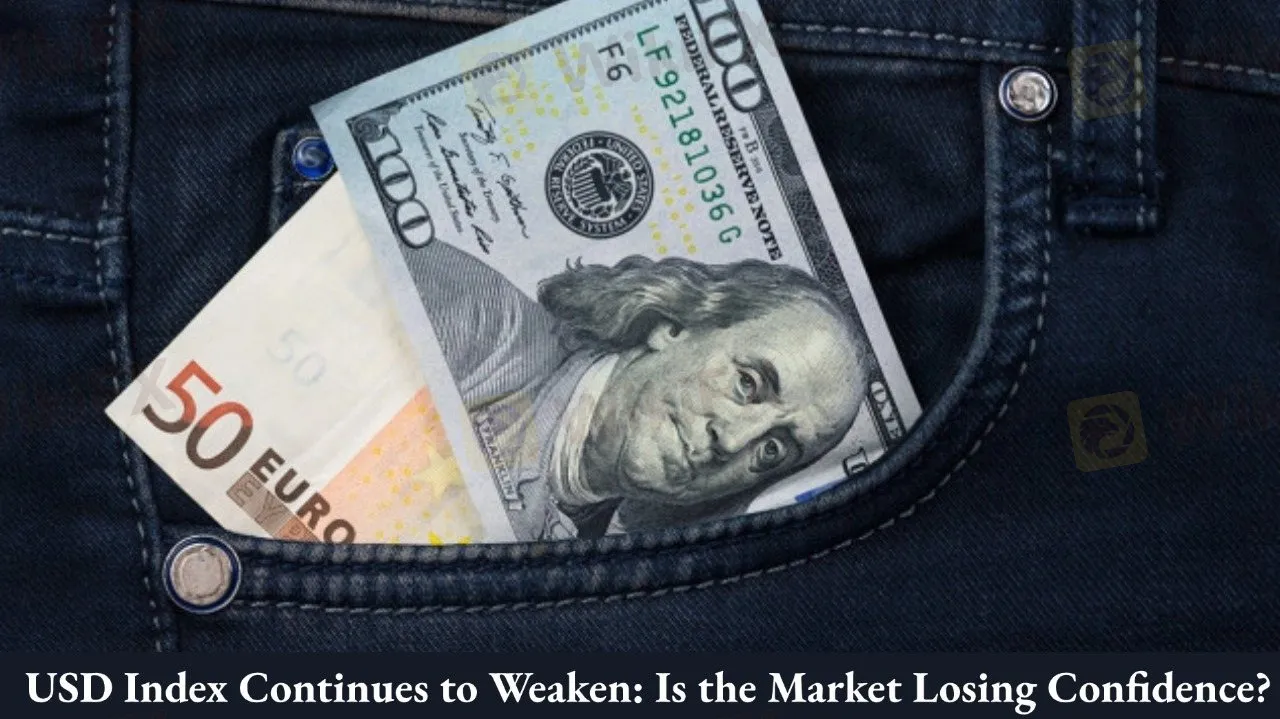简体中文
繁體中文
English
Pусский
日本語
ภาษาไทย
Tiếng Việt
Bahasa Indonesia
Español
हिन्दी
Filippiiniläinen
Français
Deutsch
Português
Türkçe
한국어
العربية
USD Index Continues to Weaken: Is the Market Losing Confidence?
Abstract:Recently, the USD index has continued to weaken, with a noticeable shift in market sentiment. Investor optimism is fading as key policy decisions and trade negotiations loom, creating uncertainty about future trends.

On May 6, the USD index continued its downward trajectory, with market optimism about trade agreements fading and increased volatility in emerging Asian currencies putting further pressure on the USD. As the Federal Reserve and Bank of Englands policy meetings approach, investor sentiment has become more cautious, and technical indicators show that the market is in a consolidation phase. According to the 60-minute chart, the USD index is hovering around the middle Bollinger Band (99.81), signaling a short-term balance with a slightly bearish bias. The technical indicators show that the market is caught in a tug-of-war between bulls and bears, and no clear trend has emerged.
On the 240-minute chart, the USD index shows a wider range within the Bollinger Bands (upper band at 100.27, middle band at 99.89, and lower band at 99.51). The current price of 99.78 is above the middle band, indicating a weak bullish inclination in the medium term, but momentum is insufficient for a strong upward movement. Overall, the USD index is in a consolidation phase, and market sentiment has not provided any clear direction.
Reasons Behind the Weakening USD Index
The weakness in the USD index can primarily be attributed to two factors. First, market expectations for a trade agreement between the US and China have turned more pessimistic. Previously, there was optimism about tariff reductions, but now, with negotiations stalling, the market is becoming increasingly cautious. As one prominent forex strategist stated, “The previous optimism about a trade agreement has faded, and investors are starting to focus on the potential impact of tariffs on the global economy.” This shift in sentiment has led to a reduction in demand for the USD, with funds flowing into safe-haven assets or other currencies.
Secondly, the Federal Reserve's policy stance is also influencing the USD. The market widely expects that the Federal Reserve will keep interest rates unchanged in its upcoming meeting. However, investors are closely watching the Fed's language regarding the economic outlook and its stance on future rate hikes. Meanwhile, the Bank of England faces growing pressure to address the slowing economy, and a rate cut could be on the horizon. This central bank policy battle is adding further uncertainty to the USD's outlook.
In the near term, the USD index is likely to continue fluctuating within a narrow range. The 60-minute chart shows tight trading intervals, while the 240-minute chart indicates a wider range, signaling that the market is waiting for policy decisions and trade news to guide the next move. If the Federal Reserve adopts a more hawkish stance or there is a breakthrough in trade negotiations, the USD could experience a short-term rebound. On the other hand, if risk sentiment rises and capital continues to flee the USD, further weakness could ensue.
In the medium term (1-2 weeks), both technical and fundamental factors lack clear direction. However, the risk of further downside is gradually building. If the trend of capital inflows into emerging markets continues, combined with major central banks' easing policies, the USD index could test key support levels around 99.00. Investors will need to closely monitor forward guidance from policy statements and developments in Asian currency markets, as unexpected news could trigger a sharp reversal.
Challenges Investors Will Face in the Future
For investors, the ongoing weakness in the USD index presents a more uncertain investment environment. A weak USD may push capital toward emerging market currencies or other safe-haven assets, particularly in the context of trade uncertainty and policy changes. Investors must balance technical and fundamental factors and remain alert to Federal Reserve and other central bank policy statements to adjust their strategies accordingly.
In the short term, the USD index is likely to remain in a consolidation phase. The 60-minute chart shows a narrow range, while the 240-minute chart indicates a broader range, suggesting the market is waiting for external catalysts, such as policy meetings and trade updates. If the Federal Reserve adopts a more hawkish tone or there is progress in trade negotiations, the USD may experience a short-term rebound. Conversely, increasing risk aversion may lead to further capital outflows from the USD.
In the medium term, there is no clear direction from either technical or fundamental indicators, but the risks are skewed to the downside. If capital continues to flow into emerging markets, coupled with easing policies from major central banks, the USD could face further pressure. Investors should pay close attention to policy statements and any sudden changes in market sentiment, as unexpected news could quickly alter the trend.
The continued weakness in the USD index reflects the market's growing uncertainty about the future economic outlook and trade developments. Although the USD may continue to consolidate in the short term, the risk of further downside is increasing. Investors need to be vigilant about policy changes and global economic conditions, as these could drive market trends. In this uncertain environment, diversification and flexible investment strategies are key to navigating the challenges ahead. As volatility increases, traders should prioritize risk management and wait for clearer signals before committing to major positions.

Disclaimer:
The views in this article only represent the author's personal views, and do not constitute investment advice on this platform. This platform does not guarantee the accuracy, completeness and timeliness of the information in the article, and will not be liable for any loss caused by the use of or reliance on the information in the article.
Read more

Voices of the Golden Insight Award Jury | George Georgiou, the Co-Founder of Dynamic Works
WikiFX Golden Insight Award uniting industry forces to build a safe and healthy forex ecosystem, driving industry innovation and sustainable development, launches a new feature series — “Voices of the Golden Insight Awards Jury.” Through in-depth conversations with distinguished judges, this series explores the evolving landscape of the forex industry and the shared mission to promote innovation, ethics, and sustainability.

Prop Firm Tradeify Signs ‘The Nuke’ as Global Brand Ambassador
Miami-based prop trading firm Tradeify has officially announced a major long-term partnership with Luke “The Nuke” Littler, the current World Number 1 and reigning 2024/2025 PDC Darts World Champion. Littler joins Tradeify as its new Global Brand Ambassador, marking one of the company’s most significant branding investments to date.

Close Up With WikiFX —— Take A Close Look At Amillex
With the rapid growth of global multi-asset investment markets, the differences among regional forex markets have become increasingly significant. As a forex broker information service platform operating in more than 180 countries and regions, WikiFX is dedicated to helping investors in every market identify reliable brokers. Therefore, we have launched an exclusive interview series —— "Close Up With WikiFX", offering in-depth conversations with local brokers. This series aims to dive deep into frontline markets and provide first-hand information, helping investors gain a clearer and more comprehensive understanding of quality brokers.

Cloudflare Outage Disrupts Broker Websites and Crypto Platforms
Cloudflare outage causes widespread disruption to broker websites and crypto platforms, highlighting risks in web infrastructure reliance.
WikiFX Broker
Latest News
Close Up With WikiFX —— Take A Close Look At Amillex
GGCC Bonus and Promotions: A Data-Driven Analysis for Experienced Traders
AccentForex Review: Is It Safe to Invest or Scam?
Questrade Review Pros, Cons and Regulation
CapEx Spending On AI Is Masking Economic Weakness
Is Your Money Safe? The Capital.com Withdrawal Mystery Revealed
World Forex Review: Does the Broker Deny Withdrawals and Scam Traders via Fake Bonuses?
Revolut Expands in South Africa with Banking Licence Move
The Broker Dilemma: Why Your Choice Could Make or Break Your Forex Journey
【WikiEXPO Global Expert Interviews】Sheikh Muhammad Noman: The Future of Investment in the GCC
Currency Calculator



